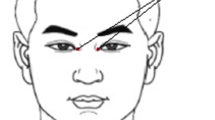Abstract
Objective
To observe the influence of electroacupuncture (EA) on histomorphologies of lacrimal glands, cornea and conjunctiva in experimental dry eye syndrome, and to explore the repair effects of EA on lacrimal glands and ocular surface damage.
Methods
Twenty-four healthy male New Zealand rabbits were randomly divided into a normal group, a model group, an EA group and a medication group, 6 rabbits in each group. Experimental dry eye syndrome models were prepared in rabbits by using 0.1% benzalkonium chloride for eye drops. Tear secretion volume, break-up time of tear film (BUT) and corneal fluorescein staining score were observed before and after the treatment. Periodic acid Schiff (PAS) staining method was used to observe the changes of conjunctival goblet cells in rabbits. After hematoxylin eosin (HE) staining, morphological changes of rabbit cornea, conjunctiva and lacrimal gland tissues were observed under light microscope.
Results
Compared with the normal group, tear secretion volume and BUT were significantly reduced (both P<0.01), while the corneal fluorescein staining score was significantly increased (P<0.01) in the model group. Compared with the model group, tear secretion volume and BUT were significantly increased, while the corneal fluorescein staining score was significantly decreased in the EA group and the medication group (all P<0.01). Compared with the normal group, the number of conjunctival goblet cells in the model group was significantly reduced; compared with the model group, the numbers of conjunctival goblet cells were all relatively higher in the EA group and the medication group. Pathological lesions of cornea, conjunctiva and lacrimal glands all showed improvement by HE staining in the EA group and the medication group after the intervention.
Conclusion
EA can improve tear secretion and tear film stability of rabbit dry eye syndrome, and repair the pathologic lesions of conjunctival goblet cells, corneal epithelia, cornea, conjunctiva and lacrimal glands.
摘要
目的
观察电针对实验性干眼症兔泪腺、角膜和结膜组织形态学的影响, 探讨电针对干眼症泪腺和眼表损伤的修复作用。
方法
健康雄性新西兰兔24 只, 随机分为正常组、模型组、电针组和药物组, 每组6 只。采 用0.1%苯扎氯铵滴眼制备兔实验性干眼症模型, 观察治疗前后实验性干眼症兔的泪量、泪膜破裂时间(break-up time, BUT)和角膜荧光素钠染色评分; 应用PAS 染色法观察兔结膜杯状细胞的变化; 采用苏木精伊红 (hematoxylin eosin, HE)染色, 光镜下观察兔角膜、结膜、泪腺 组织形态学的变化。
结果
与正常组比较, 模型组泪量、BUT 均显著减少(均P<0.01), 角膜荧光素钠染色评分显著增加(P<0.01)。与模型组比较, 电针组和药物组的泪量、BUT 均显著增加(均P<0.01), 角膜荧光素钠染色评分均显著降低(均P<0.01)。与正常组比较, 模型组结膜杯状细胞数 量显著减少; 与模型组比较, 电针组和药物组结膜杯状细胞数量均相对较多。HE 染色结果显示, 电针组、药物组 干预后角膜、结膜、泪腺组织的病理损伤均有一定改善。
结论
电针对干眼症兔泪液分泌和泪膜稳定性均具有 一定的改善作用, 对结膜杯状细胞、角膜上皮损伤和角、结膜及泪腺的病理损伤均具有一定的修复作用。
Similar content being viewed by others
References
Hui YN. Ophthalmology. 5th Edition. Beijing: People’s Health Publishing House, 2002: 60.
The definition and classification of dry eye disease: report of the definition and classification subcommittee of the international dry eye workshop. Ocul Surf, 2007, 5(2): 75–92.
Corneal Disease Group of Ophthalmology Society, Chinese Medical Association. Experts’ consensus about clinical diagnosis and treatment of dry eye. Chin J Ophthalmol, 2013, 49(1): 73–75.
Zhang CF, Huang XR, Zeng J, Ma S. Traditional Chinese medicine in treatment of dry eye syndromes. Beijing Zhongyiyao, 2008, 27(1): 63–65.
Gong L, Sun XH, Ma XP, Zhao NQ. Effect of acupuncture on the tear secretion and morphological changes of lacrimal glands in rabbit. Chin J Ophthalmol, 2006, 42(9): 835–837.
Song YG. Efficacy of acupuncture on dry eye syndromes. J Med Theor & Prac, 2016, 29(1): 76–77.
Su J, Liu XQ, Miao WH, Zhang YJ. Acupuncture therapy in treating keratoconjunctivitis sicca: a systematic review. Zhongguo Zhongyi Yanke Zazhi, 2014, 24(1): 40–46.
Guo MH, Cui EC, Li XY, Zong L. Observations on the clinical therapeutic effect of electroacupuncture on xerophthalmia. Shanghai Zhenjiu Zazhi, 2012, 31(4): 245–247.
Ma XP, Yang L, Mo WQ, Shi Z, Zhao CY. Summary on clinical experience of acupuncture treating dry eye syndromes. J Acupunct Tuina Sci, 2009, 7(3): 134–136.
Jeon JH, Shin MS, Lee MS, Jeong SY, Kang KW, Kim YI, Choi SM. Acupuncture reduces symptoms of dry eye syndrome: a preliminary observational study. J Altern Complement Med, 2010, 16(12): 1291–1294.
Shi JL, Miao WH. Effects of acupuncture on lactoferrin content in tears and tear secretion in patients suffering from dry eyes: a randomized controlled trial. Chin J Integr Med, 2012, 10(9): 1003–1008.
Li CY, Song YY, Luan SH, Wan PX, Li NY, Tang J, Han Y, Xiong CJ, Wang ZC. Research on the stability of a rabbit dry eye model induced by topical application of the preservative benzalkonium chloride. PloS One, 2012, 7(3): e33688.
Xiong CJ, Chen D, Liu JB, Liu BQ, Li NY, Zhou Y, Liang XW, Ma P, Ye CT, Ge J, Wang ZC. A rabbit dry eye model induced by topical medication of apreservative benzalkonium chloride. Invest Ophthalmol Vis Sci, 2008, 49(5): 1850–1856.
Cai LP, Zhang H. Research progress on inflammatory immunity related signaling pathway for pathogenesis of dry eye. Guoji Yanke Zazhi, 2016, 16(6): 1084–1088.
Su MC, Hao XL, Zhang ZC. Inflammatory mechanisms in ocular surface damage of dry eye. Int Eye Sci, 2015, 15(5): 821–824.
Liu XX. Clinical Research about the efficacy of acupuncture on dry eye syndromes and its influence on life quality and mental state. Master Thesis of Shanghai University of Traditional Chinese Medicine, 2014.
Lin T, Gong L, Liu X, Ma X. Fourier-domain optical coherence tomography for monitoring the lower tear meniscus in dry eye after acupuncture treatment. Evid Based Complement Alternat Med, 2015: 492150.
Zhang LL, Zhang CH, Ma XP, Yang L, Hong J, Wu LX, Liu J. Current situation and prospects of acupuncture in the treatment of dry eye. JCAM, 2014, 30(1): 62–66.
Cong CY, Bi HS, Wen Y. Research advance of the pathogenesis and treatment of dry eye. Int Eye Sci, 2012, 12(3): 464–467.
Liang XQ, Liu Y, Zheng BT, Wang SS, Sun XD, Xu X. Correlation of conjunctival impression cytology with symptoms and signs of dry eye. Shanghai Jiaotong Daxue Xuebao: Yixue Ban, 2012, 32(2): 177–180.
Author information
Authors and Affiliations
Corresponding author
Rights and permissions
About this article
Cite this article
Zhang, Ch., Zhang, Ll., Zhang, D. et al. Influence of electroacupuncture on histomorphology of lacrimal glands and ocular surface in experimental dry eye syndrome. J. Acupunct. Tuina. Sci. 14, 320–327 (2016). https://doi.org/10.1007/s11726-016-0943-1
Received:
Accepted:
Published:
Issue Date:
DOI: https://doi.org/10.1007/s11726-016-0943-1




